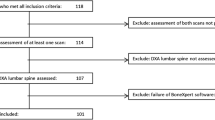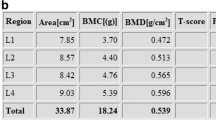Abstract
Background
In recent years interest in bone densitometry in children has increased.
Objective
To evaluate the clinical application of digital X-ray radiogrammetry (DXR) and compare the results with those of dual-energy X-ray absorptiometry (DXA).
Materials and methods
A total of 41 children with acute lymphoblastic leukaemia (ALL) and 26 children with growth hormone deficiency (GHD) were included in this longitudinal study. Radiographs of the left hand were obtained and used for DXR. DXA of the total body and of the lumbar spine was performed.
Results
In both study populations significant correlations between DXR and DXA were found, and, with the exception of the correlation between DXR bone mineral density (DXR-BMD) and bone mineral apparent density in the GHD population, all correlations had a P-value of <0.001. During treatment a change in DXR-BMD was found in children with GHD.
Conclusions
Our study showed that DXR in a paediatric population shows a strong correlation with DXA of the lumbar spine and total body and that it is able to detect a change in BMD during treatment.



Similar content being viewed by others
References
Genant HK, Engelke K, Fuerst T, et al (1996) Noninvasive assessment of bone mineral and structure: State of the art [review]. J Bone Miner Res 11:707–730
Fässler AC, Bonjour J-P (1995) Osteoporosis as a pediatric problem. Pediatr Clin North Am 42:811–824
Bonjour J-P, Theintz G, Buchs B, et al (1991) Critical years and stages of puberty for spinal and femoral bone mass accumulation during adolescence. J Clin Endocrinol Metab 73:555–563
Boot AM, Bouquet J, de Ridder MA, et al (1997) Determinants of body composition, measured by dual X-ray absorptiometry, in Dutch children and adolescents. Am J Clin Nutr 66:232–238
Chan GM (1992) Performance of dual-energy X-ray absorptiometry in evaluating bone, lean body mass, and fat in pediatric subjects. J Bone Miner Res 7:369–374
Henderson RC, Lark RK, Newman JE, et al (2002) Pediatric reference data for dual X-ray absorptiometric measures of normal bone density in the distal femur. AJR 178:439–443
Southard RN, Morris JD, Mahan JD, et al (1991) Bone mass in healthy children: measurement with quantitative DXA. Radiology 179:735–738
Van der Sluis IM, de Ridder MA, Boot AM, et al (2002) Reference data for bone density and body composition measured with dual energy X-ray absorptiometry in white children and young adults. Arch Dis Child 87:341–347
Yirtama P, Mahonen H (1960) Thickness of the cortical layer as an estimate of mineral content of human finger bones. Br J Radiol 6:60–62
Rosholm A, Hyldstrup L, Bæksgaard L, et al (2001) Estimation of bone mineral density by digital X-ray radiogrammetry: theoretical background and clinical testing. Osteoporos Int 11:961–969
Bouxsein ML, Palermo L, Yeung C, et al (2002) Digital X-ray radiogrammetry predicts hip, wrist and vertebral fracture risk in elderly women: a prospective analysis from the study of osteoporotic fractures. Osteoporos Int 13:358–365
Mentzel HJ, John U, Boettcher J, et al (2005) Evaluation of bone-mineral density by digital X-ray radiogrammetry (DXR) in pediatric renal transplant recipients. Pediatr Radiol 35:489–494
van Rijn RR, Grootfaam DS, Lequin MH, et al (2004) Digital radiogrammetry of the hand in a pediatric and adolescent Dutch Caucasian population: normative data and measurements in children with inflammatory bowel disease and juvenile chronic arthritis. Calcif Tissue Int 74:342–350
Van der Sluis IM, van den Heuvel-Eibrink MM, Hahlen K, et al (2002) Altered bone mineral density and body composition, and increased fracture risk in childhood acute lymphoblastic leukemia. J Pediatr 141:204–210
van der Sluis IM, Boot AM, Hop WC, et al (2002) Long-term effects of growth hormone therapy on bone mineral density, body composition, and serum lipid levels in growth hormone deficient children: a 6-year follow-up study. Horm Res 58:207–214
Carter DR, Bouxsein ML, Marcus R (1992) New approaches for interpreting projected bone densitometry data. J Bone Miner Res 7:137–145
Reed MR, Murray JR, Abdy SE, et al (2004) The use of digital X-ray radiogrammetry and peripheral dual energy X-ray absorptiometry in patients attending fracture clinic after distal forearm fracture. Bone 34:716–719
Ward KA, Cotton J, Adams JE (2003) A technical and clinical evaluation of digital X-ray radiogrammetry. Osteoporos Int 14:389–395
Boonen S, Nijs J, Borghs H, et al (2005) Identifying postmenopausal women with osteoporosis by calcaneal ultrasound, metacarpal digital X-ray radiogrammetry and phalangeal radiographic absorptiometry: a comparative study. Osteoporos Int 16:93–100
WHO Study Group (1994) Assessment of fracture risk and its application to screening for postmenopausal osteoporosis. Geneva: WHO Technical report series
Acknowledgement
We would like to thank Sectra-Pronosco (Linköping, Sweden) for supplying the X-posure system for this study.
Author information
Authors and Affiliations
Corresponding author
Rights and permissions
About this article
Cite this article
van Rijn, R.R., Boot, A., Wittenberg, R. et al. Direct X-ray radiogrammetry versus dual-energy X-ray absorptiometry: assessment of bone density in children treated for acute lymphoblastic leukaemia and growth hormone deficiency. Pediatr Radiol 36, 227–232 (2006). https://doi.org/10.1007/s00247-005-0080-3
Received:
Revised:
Accepted:
Published:
Issue Date:
DOI: https://doi.org/10.1007/s00247-005-0080-3




